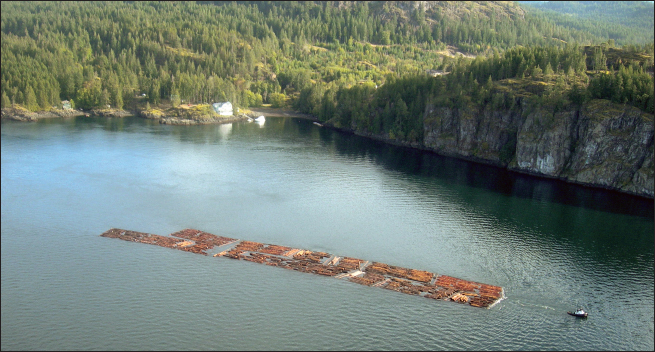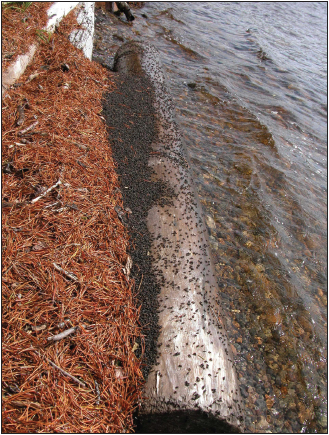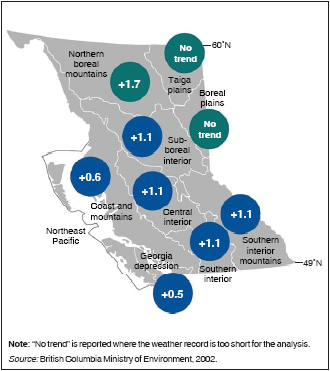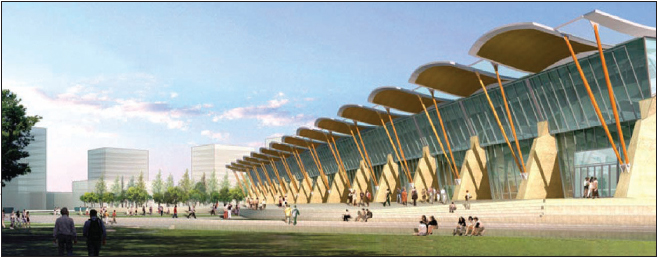D. Konkin and K. Hopkins
Doug Konkin is Deputy Minister, Forests and Range, Province of British Columbia, Victoria, Canada.
Kathy Hopkins is Technical Advisor – Climate Change, British Columbia Forest Service, Victoria, Canada.
A devastating outbreak of mountain pine beetle in the province of British Columbia, Canada creates challenges – but also opportunities – for policy-makers, forest industry and society
The mountain pine beetle, Dendroctonus ponderosae, is a native bark beetle of the lodgepole pine forests of western Canada that periodically builds to outbreak levels. However, since the late 1990s, populations have grown to an unprecedented scale, now attacking more than 13 million hectares of forest in the province of British Columbia – an area about the size of England. The epidemic may be attributed to multiple causes, including climate change and other factors such as forest management interventions. By 2015 the epidemic is expected to kill more than three-quarters of the pine volume in British Columbia. This represents over 900 million cubic metres of timber that was expected to contribute to the economic wealth of British Columbia’s communities. In these communities climate change is no longer a theoretical matter – the impacts are real now.
This epidemic creates challenges on multiple fronts, but it has also led to new economic opportunities for British Columbia. It has in addition been a catalyst for increased collaboration among rural communities, natural resource industries and government agencies, and it has fostered new ways of thinking about forest management in the context of climate change and social objectives.
British Columbia, Canada’s most westerly province, covers about 95 million hectares on the rugged Pacific coast. Two-thirds of its land area is forested, an area larger than France. Ninety-five percent of the province’s forest land is publicly owned and managed by the British Columbia Ministry of Forests.
Forest products represented about 40 percent of the total value of all of British Columbia’s exports from 1996 to 2004 (Can$15 billion [US$12 billion] per year). Forestry is the main employer in many rural communities. In 2007, the forest sector accounted for 84 000 jobs and 6.8 percent of total provincial gross domestic product. In addition to timber values, British Columbia’s forests store carbon and supply water for domestic, industrial and other uses. They provide important cultural values, sustenance for First Nations peoples and a setting for tourism and recreation.
| A raft of logs being towed to the mill illustrates the importance of forestry to the economy of the Canadian province of British Columbia |
 |
FAO/FO-6873/J. Ball |
In British Columbia, lodgepole pine (Pinus contorta) is the single most plentiful tree species, making up 23 percent of the provincial growing stock. It grows throughout most of the province’s interior from middle to subalpine elevations. It is a preferred host for mountain pine beetle. At endemic levels, this beetle breeds in weakened large-diameter trees. At epidemic levels, it attacks and kills healthy trees over large areas.
Over the past century, successful fire suppression and social constraints on harvesting led to the growth of large areas of contiguous stands of pine which have recently come to maturity, providing the mountain pine beetle with ideal habitat. The ease with which the epidemic spread through these stands has shown the value of managing age class distributions and increasing species diversity at the landscape level, as a more diverse array of species and age class distributions across the landscape would have reduced the exposure of the province’s interior forests to a single insect or pathogen.
| Mountain pine beetles washed up on a lakeshore give an idea of the severity of the outbreak |
 |
British Columbia Ministry of Forests and Range |
Over the past decade, British Columbia has not experienced the extreme cold winter temperatures that curtailed previous outbreaks. Warming in British Columbia over the twentieth century (to 1995) was approximately equal to the global average of 0.6ºC on the coast (British Columbia Ministry of Environment, 2002; IPCC, 2001), but two or three times higher in the interior (Figure 1).
The higher winter temperatures led to increased winter survival of the mountain pine beetle, which has culminated in the largest beetle epidemic in the province’s recorded history. By 2008, it had affected about half a billion cubic metres.
| Changes in average temperature in British Columbia during the twentieth century |
 |
The mountain pine beetle outbreak has had (or will have) many negative environmental and socio-economic impacts. Environmental impacts are not limited to the loss of mature forest cover. For example, local water table and hydrological cycles have changed. Interior forests have become a carbon source rather than a sink, and are expected to remain so until 2020. Plant and animal habitat is affected.
Although negative economic impacts will be felt over the longer term, in the short term there have been some benefits. For example, until the recent decline in the United States housing market dampened the demand for timber, economic activity in affected areas increased as the forest sector attempted to salvage as much merchantable timber as possible from beetle-killed trees before they would degrade.
There is significant variability in the length of time dead pine is useful for dimension timber, but trials have shown that in some areas beetle-damaged timber can be used up to 15 years after attack, and even later for processing into oriented strand board, wood pellets and other products (FPInnovations – Forintek, 2008; J.S. Thrower and Associates, 2007a, 2007b; Timberline Natural Resource Group, 2008). On average, the estimated shelf-life for individual pine trees ranges from 5 to 10 years, and that of pine stands from 8 to 12 years. However the dry wood degrades in quality from weather damage, splits easily and has a reduced recovery rate, so timber manufacturers have had to develop new technologies to confront this problem.
Eventually, British Columbia will exhaust the economic benefits of the large amounts of available dead wood. In some areas the mid-term timber supply will be reduced to half of the pre-outbreak harvest levels.
In the face of a massive and expanding insect infestation, British Columbia’s first action was to try to limit the spread of the outbreak. Early it became clear that the epidemic was too vast to eliminate or control, and significant funds were devoted to slowing the rate of infestation on the outer edges of the outbreak, to keep the infestation from spreading over the Rocky Mountains and into the boreal forest. Unfortunately, hopes for severely cold winter temperatures to kill insect broods have not been met, and by 2007, the beetle had spread over the Rocky Mountains on wind currents.
| Treating mountain pine beetle with fire |
 |
Pro-Tech Forest Resources Ltd |
In the central area of the outbreak, efforts quickly shifted towards maximizing recovery of the economic value of dead timber before it would deteriorate. In the management units most affected, harvesting has been concentrated in stands where pine represented more than 70 percent of the available timber volume. Allowable harvest levels have been temporarily raised and policy has been changed to facilitate harvesting in these areas. Operators have moved from adjacent non-affected areas to focus on harvesting of beetle-attacked trees.
While the increase in salvage harvesting has increased wood processing recently, over the longer term the beetle outbreak may have significant economic, social and cultural impacts on communities that have relied on logging and sawmilling for decades. British Columbia is investing in coalitions to increase community resilience by diversifying economic opportunities. These efforts are designed to provide long-term stability in a way that reflects local aspirations.
The forest sector has also been working to mitigate the impacts on the mid-term timber supply. Approximately 30 percent of the dead pine stands have sufficient understorey to be considered fully or partially stocked. These young trees will contribute to the mid-term timber supply in many areas. Identifying and protecting understorey trees during logging operations has become an important issue.
The province has allocated new funding to reforest beetle-killed pine areas that will not be salvage harvested. In 2005 the British Columbia Government initiated a reforestation programme to ensure that the areas deforested by wildfire and mountain pine beetle grow into productive healthy forests. Support for the programme has increased to over Can$50 million (US$40 million) per year. This programme will improve the future timber supply and address risks to other forest values by re-establishing young forests on land that would otherwise remain underproductive. The reforestation programme currently plants 8 million seedlings per year and will grow to 18 million seedlings by 2010. Seventy-five million seedlings will be planted through this programme over the next five years.
Partners in government, academia and industry are undertaking research into new manufacturing techniques, improvements in milling capacity and development of alternative products from beetle-attacked timber. So far, Can$5.9 million (US$4.7 million) has been allocated to research and development of new products and to improvement of manufacturing processes.
Because wood compares favourably with concrete and steel in both greenhouse gas emissions and energy consumption in processing, British Columbia is pushing to make wood the first choice for construction. The 2010 Olympic Speed Skating Oval for the 2010 Winter Olympic Games near Vancouver is a showcase example. One million board feet of sawnwood (2 360 m3 [full sawn]), mostly from beetle-killed trees, were used in the 2.6 ha roof.
Because British Columbia has abundant hydroelectric power and lower reliance on fossil fuels than some jurisdictions, the province is just beginning to pursue alternative energy sources. However, the province’s wood pellet industry is expanding rapidly; it produced almost 1 million tonnes of wood pellets in 2008, directly and indirectly employing about 300 people and generating more than Can$170 million (US$136 million) in revenue, primarily from exports to Europe. The abundance of cheap wood made available by the beetle infestation has also stimulated interest in cellulose-based bioenergy. British Columbia, like other jurisdictions, is moving up the value-added ladder towards gasification and other energy products, all depending heavily on market demand.
| British Columbia is pushing to use wood in construction – the 2.6 ha roof of the 2010 Olympic Speed Skating Oval for the 2010 Winter Olympic Games near Vancouver is constructed mainly of wood from beetle-killed trees |
 |
City of Richmond, BC, Canada |
Most of British Columbia’s population lives in urban centres away from the interior forests, but the visual changes to the landscape associated with the beetle infestation and recent fires have been strong enough to create a new public awareness of forest amenity values and climate change. Bigger questions on the horizon include how climate change and forest health issues will affect traditional ways of thinking about land use, and how societal values are to be incorporated into policy decisions.
The average global temperature increase in the twenty-first century is expected to be between 1º and 6ºC (IPCC, 2007). The actual trajectory will depend on how quickly the world curbs emissions, but the increase could easily exceed that of the past hundred years. Because of its northern location, British Columbia is preparing for further increases of this magnitude or more. These changes could have significant effects on species and ecosystems.
Climate change is one of the key drivers for the research programme of the British Columbia Forest Service. The Future Forest Ecosystem Initiative (see www.for.gov.bc.ca/hts/Future_Forests) was created in 2006 to adapt the province’s forest management policies and practices to increase the resilience of forest and range ecosystems. Resilience refers to the capacity to absorb, recover from and adapt to climate change stresses.
Government scientists have been working with the University of British Columbia and other partners to develop scenarios showing how climate changes may affect forest ecosystems in the future (Figure 2). These models lead to expectations that many of the province’s ecosystems will soon face climatic conditions that are more suitable for a different assemblage of species than at present. However, the species composition may not be able to change naturally as quickly as the climate does, so poorly adapted species on some sites will be under increased stress. Therefore scientists are investigating ways to assist migration of tree species and provenances into areas where the climate is likely to be suitable in the future.
The mountain pine beetle epidemic has demonstrated the complex and often unexpected impacts resulting from a large-scale disturbance. These can occur quickly and may overtake the government’s capacity to meet societal expectations.
The British Columbia Ministry of Forests and Range is starting to re-examine all its policies with a climate change lens. For example, its approach to tree breeding, which previously focused on growth, has been broadened to focus on both growth and resilience.
While climate change may bring some advantages for British Columbia’s forests, in the end the costs associated with agents such as fire, pests and water are likely to far outweigh the benefits. The opportunity to adjust forest management practices is limited by the very small proportion (about 0.3 percent) of forest land that is harvested each year in the province. Therefore adaptation is necessary to make both communities and economies more resilient.
Adjustment of natural and human systems to moderate the harm resulting from climate change cannot alone solve all the problems. Aggressive climate change mitigation is essential to effective adaptation. To do its part to reduce emission of the greenhouse gases that contribute to climate change, the British Columbia government has introduced a revenue-neutral carbon tax on greenhouse gas emissions produced from burning fossil fuels. The tax puts a price on each tonne of greenhouse gas emitted, creating a financial disincentive for emissions across the economy. Businesses and individuals in British Columbia can reduce their tax bill by reducing their fuel consumption, using cleaner fuels, increasing fuel efficiency or adopting new energy technology. They could even offset their emissions entirely by taking advantage of emerging carbon markets. By law, the British Columbia government must show how all of the province’s carbon tax revenue flows back to individuals and businesses as tax reductions.
British Columbia is also participating with seven states in the United States and four Canadian provinces in the Western Climate Initiative, which is developing a cap and trade system to reduce greenhouse gas emissions from facilities emitting 100 000 tonnes or more of carbon dioxide equivalents per year. While deforestation in the province is small, the province is also working on provisions to reduce or eliminate net deforestation.
British Columbia is moving towards scenario-based planning and considering ways to build adaptive capacity in the overall forest management system. All issues are people issues, and the solution to the province’s environmental challenge lies with people. Science is vital to climate change solutions but is not sufficient alone.
Currently there is public pressure to conserve old trees and to reduce or eliminate fires for air quality and other reasons. However, old trees fall prey to disturbance agents such as the mountain pine beetle, and as climate changes, public pressure to avoid burning could impair efforts to maintain healthy stands.
The British Columbia government is working to build awareness of climate change and to increase individual and organizational innovation in solving related problems. In order to succeed in addressing climate change, behavioural change is key, but most people do not change their behaviour because of data or information. It is important to recognize that climate change impacts are products of underlying patterns of human behaviour. To change those patterns and behaviours it is imperative not only to make strategic adjustments to business systems and incentives, but also to tell a compelling story and appeal to human emotions as well as reason.
The mountain pine beetle epidemic has broadened the thinking and approach of British Columbia’s forest managers. It has highlighted the potential for unintended consequences of human intervention in natural systems, and increased recognition of the need to develop resilience in ecosystems, people and communities.
To tackle the systemic challenges presented by climate change, the provincial government is developing robust systems for organizational learning, with a supportive learning environment, progressive leadership practices and active links between science and policy. It has found tremendous advantages in working across disciplines – for example forest health, timber supply analysis and community planning – to tackle climate change in a holistic way.
The problems and solutions are part of a complex system with global influences. For example, the economic growth in China affects the price of oil around the world. United States corn subsidies affect the global area of land used for fibre and food production. Russian log tariffs affect log prices in international trade. A mountain pine beetle infestation in British Columbia influences United States timber prices. All of these affect British Columbia’s ability to sustain an even supply of wood to support forest-dependent communities.
The questions outnumber the answers. British Columbia’s approach is to develop and test a range of future scenarios, not just for the climate but for ecological and human systems. This means changing how different levels of government and government agencies interact with each other, with industry and with communities. Innovations are appearing in areas of overlapping interests; for instance energy companies are partnering with forest companies, creating opportunities for new technology and new products.
No single community or agency can be prepared for the changes that will be seen in the future. Leaders need to support diversity; avoid creating rigid organizational hierarchies that deter innovation, and be inclusive, open and questioning.
“10 billion beetles can’t be wrong – buy BC pine”
![]() Bibliography
Bibliography
British Columbia Ministry of Environment. 2002. Indicators of climate change for British Columbia 2002. Victoria, British Columbia, Canada. Available at: www.env.gov.bc.ca/air/climate/indicat
FPInnovations – Forintek. 2008. Predicting yields from post MPB attacked sawlogs. Canadian Forest Service Internal Report for Project 5754.
Intergovernmental Panel on Climate Change (IPCC). 2001. Summary for policymakers. In Climate change 2001: the scientific basis. Contribution of Working Group I to the Third Assessment Report of the Intergovernmental Panel on Climate Change. Cambridge, UK & New York, USA, Cambridge University Press.
IPCC. 2007. Summary for policymakers. In S. Solomon, D. Qin, M. Manning, M. Marquis, K. Averyt, M.B. Tignor, H.L. Miller Jr. & Z. Chen, eds. Climate change 2007: the physical science basis, pp. 1–18. Contribution of Working Group I
to the Fourth Assessment Report of the Intergovernmental Panel on Climate Change. Cambridge, UK & New York, USA, Cambridge University Press.
J.S. Thrower and Associates. 2007a. Shelf life study on log quality and volumes in mountain pine beetle-killed lodgepole pine in the B.C. central interior. British Columbia Ministry of Forests and Range Internal Report for Projects MFZ-010 and MFF-006.
J.S. Thrower and Associates. 2007b. Field sampling for attributes related to the shelf life of mountain pine beetle-killed lodgepole pine in the sub-boreal spruce (SBS) biogeoclimatic zone. Canadian Forest Service Internal Report for Project 8.38.
Timberline Natural Resource Group. 2008. Preliminary analysis of mountain pine beetle shelf-life 2007 grey attack. British Columbia Ministry of Forests and Range Internal Report for Project BC0108551.